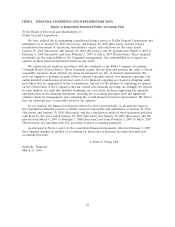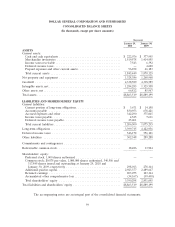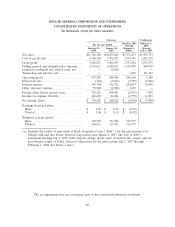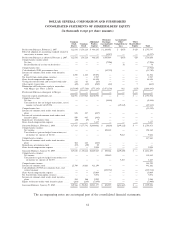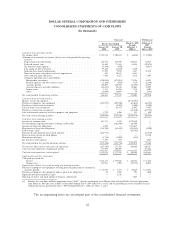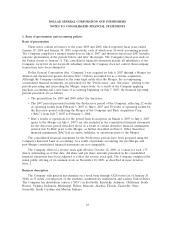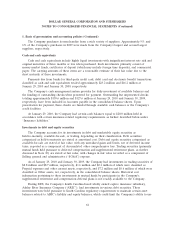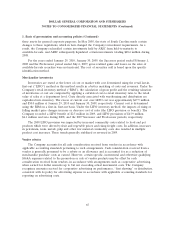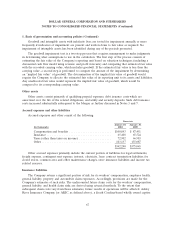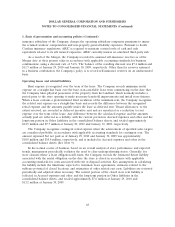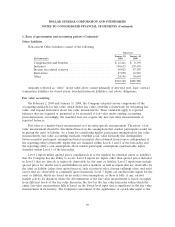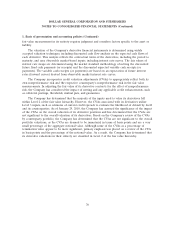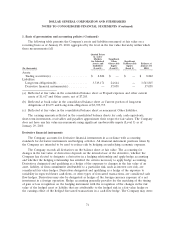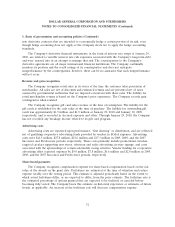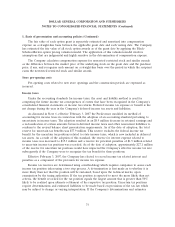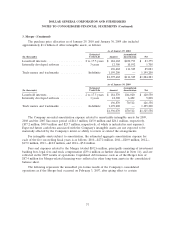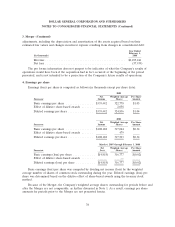Dollar General 2009 Annual Report Download - page 79
Download and view the complete annual report
Please find page 79 of the 2009 Dollar General annual report below. You can navigate through the pages in the report by either clicking on the pages listed below, or by using the keyword search tool below to find specific information within the annual report.DOLLAR GENERAL CORPORATION AND SUBSIDIARIES
NOTES TO CONSOLIDATED FINANCIAL STATEMENTS (Continued)
1. Basis of presentation and accounting policies (Continued)
insurance subsidiary of the Company, charges the operating subsidiary companies premiums to insure
the retained workers’ compensation and non-property general liability exposures. Pursuant to South
Carolina insurance regulations, ARIC is required to maintain certain levels of cash and cash
equivalents related to its self insured exposures. ARIC currently insures no unrelated third-party risk.
As a result of the Merger, the Company recorded its assumed self-insurance reserves as of the
Merger date at their present value in accordance with applicable accounting standards for business
combinations, using a discount rate of 5.4%. The balance of the resulting discount was $7.4 million and
$11.7 million at January 29, 2010 and January 30, 2009, respectively. Other than for reserves assumed
in a business combination, the Company’s policy is to record self-insurance reserves on an undiscounted
basis.
Operating leases and related liabilities
Rent expense is recognized over the term of the lease. The Company records minimum rental
expense on a straight-line basis over the base, non-cancelable lease term commencing on the date that
the Company takes physical possession of the property from the landlord, which normally includes a
period prior to the store opening to make necessary leasehold improvements and install store fixtures.
When a lease contains a predetermined fixed escalation of the minimum rent, the Company recognizes
the related rent expense on a straight-line basis and records the difference between the recognized
rental expense and the amounts payable under the lease as deferred rent. Tenant allowances, to the
extent received, are recorded as deferred incentive rent and are amortized as a reduction to rent
expense over the term of the lease. Any difference between the calculated expense and the amounts
actually paid are reflected as a liability, with the current portion in Accrued expenses and other and the
long-term portion in Other liabilities in the consolidated balance sheets, and totaled approximately
$14.5 million and $7.7 million at January 29, 2010 and January 30, 2009, respectively.
The Company recognizes contingent rental expense when the achievement of specified sales targets
are considered probable, in accordance with applicable accounting standards for contingent rent. The
amount expensed but not paid as of January 29, 2010 and January 30, 2009 was approximately
$10.8 million and $10.4 million, respectively, and is included in Accrued expenses and other in the
consolidated balance sheets (See Note 9).
In the normal course of business, based on an overall analysis of store performance and expected
trends, management periodically evaluates the need to close underperforming stores. Generally, for
store closures where a lease obligation still exists, the Company records the estimated future liability
associated with the rental obligation on the date the store is closed in accordance with applicable
accounting standards for costs associated with exit or disposal activities. Key assumptions in calculating
the liability include the timeframe expected to terminate lease agreements, estimates related to the
sublease potential of closed locations, and estimation of other related exit costs. Liabilities are reviewed
periodically and adjusted when necessary. The current portion of the closed store rent liability is
reflected in Accrued expenses and other and the long-term portion in Other liabilities in the
consolidated balance sheets, and totaled approximately $7.6 million at January 29, 2010 and
$13.2 million at January 30, 2009.
68


